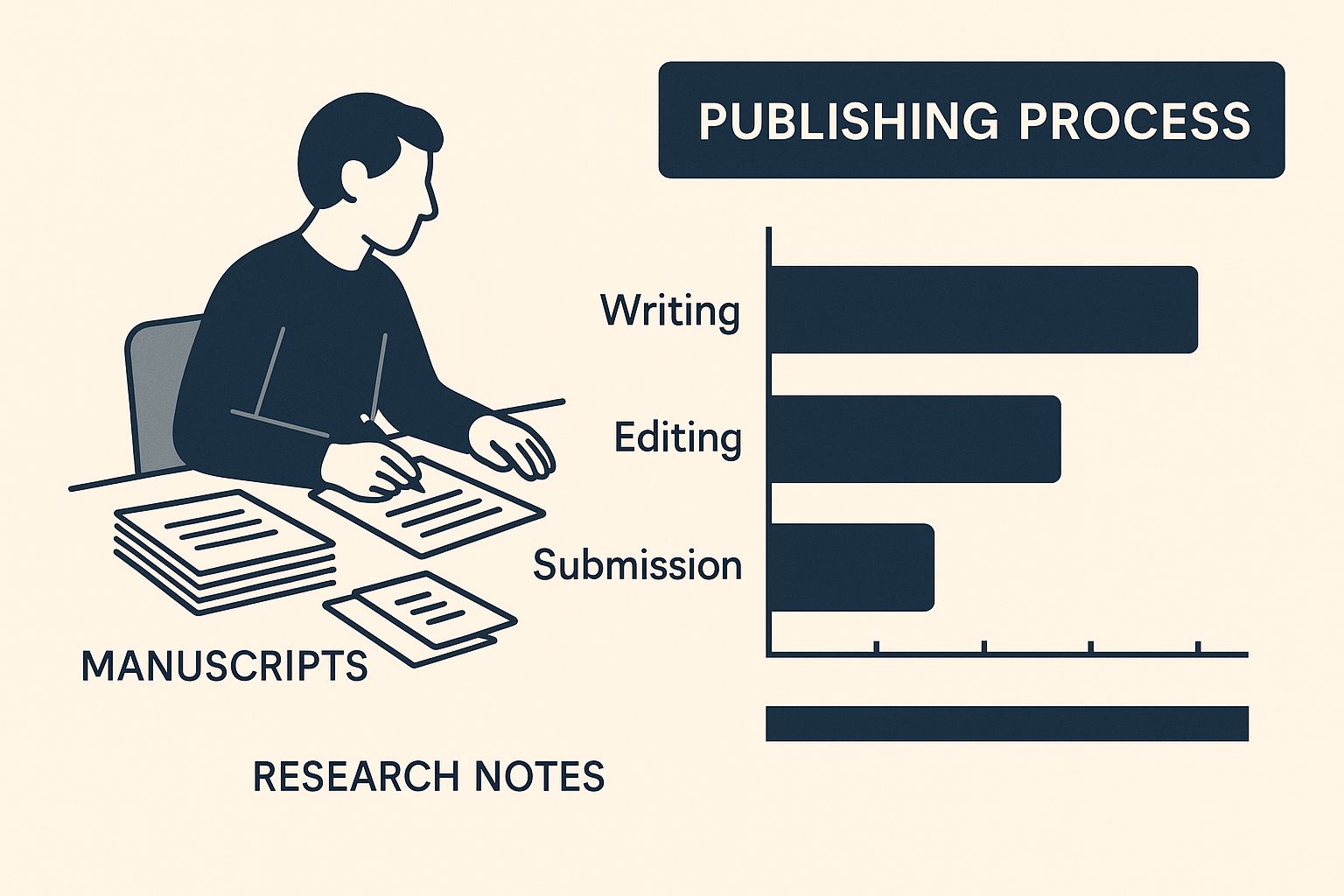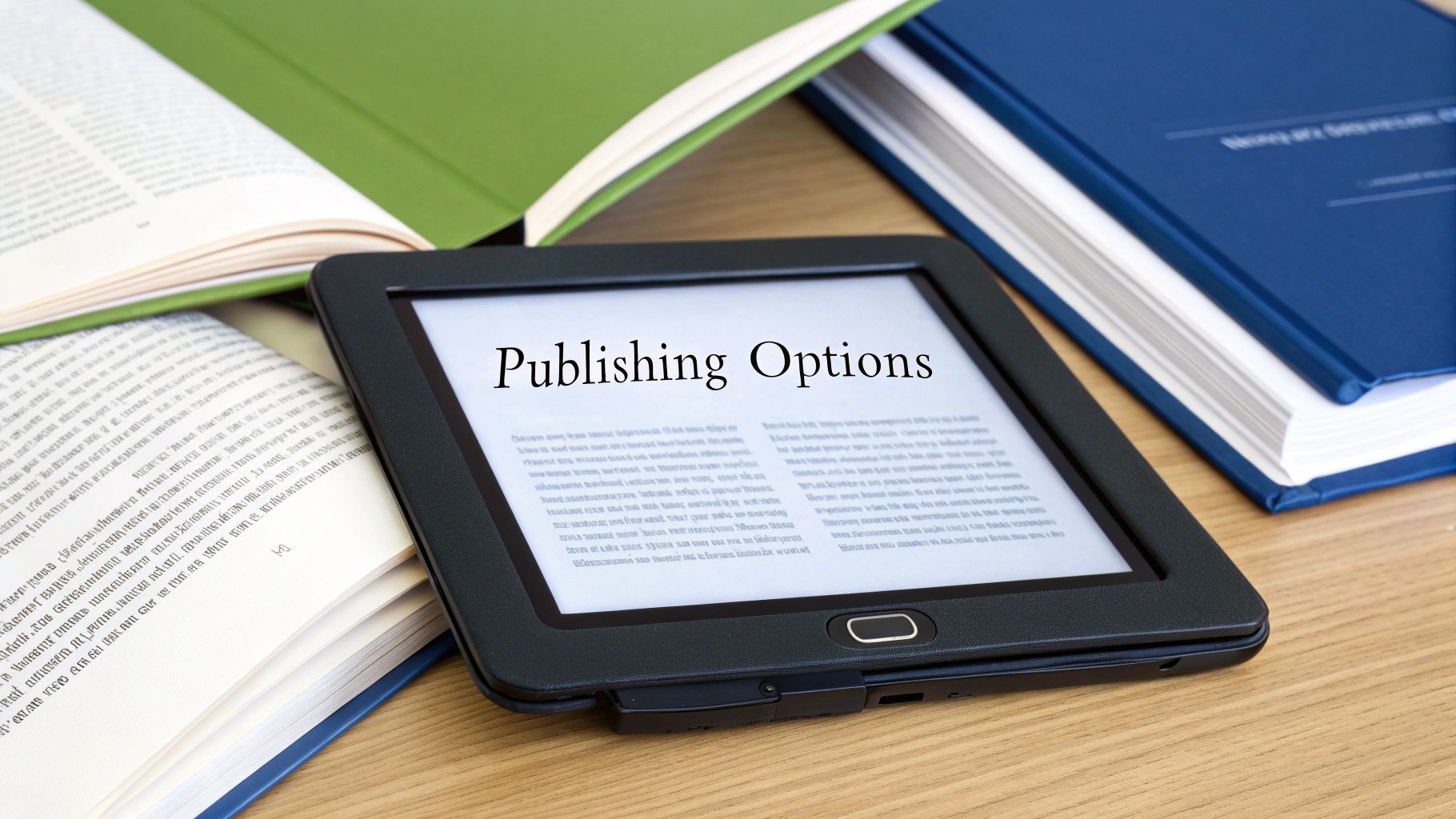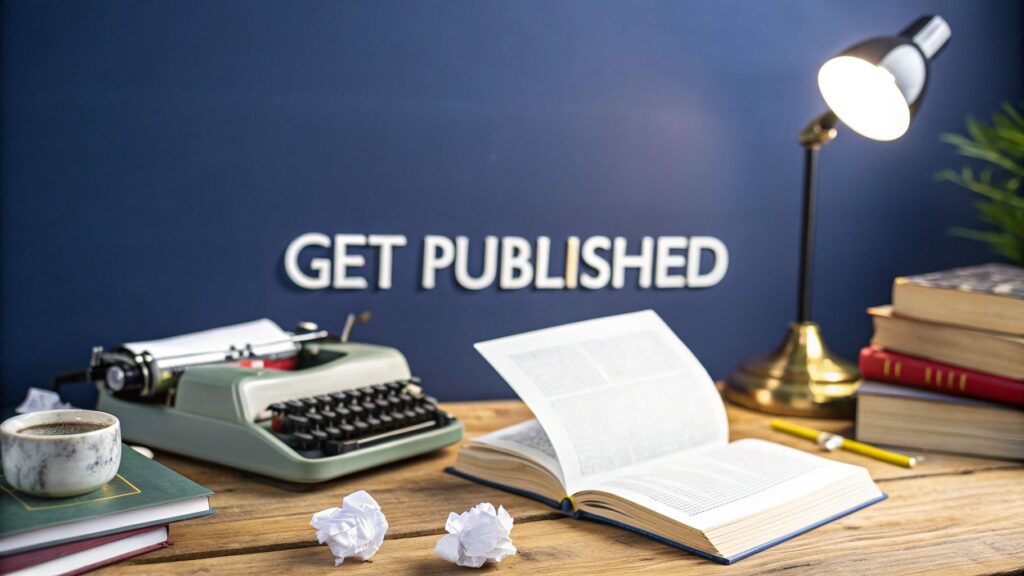Let's be blunt: getting a book deal through a traditional publisher is a monumental task. For a new author, the odds are daunting, with rejection rates commonly hitting anywhere from 90% to 99%. While self-publishing looks like a much easier door to walk through, it comes with its own set of challenges that are more entrepreneurial than literary.
So, how hard is it really to get your book published? The answer hinges entirely on which path you take.
The Two Roads of Publishing
Think of it this way: traditional publishing is like trying to get into an exclusive, heavily guarded club. Self-publishing, on the other hand, is like opening your own venue. One requires you to impress the gatekeepers, while the other requires you to build an audience from scratch. Neither is simple, and both demand a tremendous amount of work, just different kinds of work.
The traditional route is a global gauntlet. Landing a book deal is tough, particularly in competitive markets like the US and UK, where literary agents and publishers are drowning in manuscripts. Publishers have also become far more cautious, partly due to shifts in the market, making them incredibly selective about the projects they take on.
A Quick Comparison
To get a clearer picture of what you're up against, let's break down the core differences between these two worlds. The table below offers a high-level look at the main hurdles and potential rewards for each path.
Traditional vs. Self-Publishing at a Glance
| Factor | Traditional Publishing | Self-Publishing |
|---|---|---|
| Acceptance | Extremely low (1%–10% acceptance rate) | 100% acceptance (you are the publisher) |
| Upfront Cost | None for the author | Varies; can be thousands for editing, design, etc. |
| Creative Control | Limited; publisher has final say on cover, title, edits | Full; author makes all decisions |
| Timeline | Slow; 18-24+ months from signing to launch | Fast; can be published in weeks or months |
| Distribution | Strong; automatic placement in physical bookstores | Primarily online; bookstore placement is difficult |
| Marketing | Publisher support varies; author still does a lot | 100% author's responsibility |
As you can see, the "hard" part of traditional publishing is getting in the door. For self-publishing, the hard part starts the moment your book goes live.
Facing the Unvarnished Truth
The journey from a finished manuscript to a book in a reader's hands is long and filled with obstacles, regardless of the route you choose.

This image really drives home the point: whether you’re fighting for an agent's attention or battling for visibility on Amazon, success demands more than just good writing. It requires resilience and a solid plan.
Of course, before you even think about publishing, you have to write the book. If you're at the very beginning of your journey, checking out a guide to writing books for beginners can give you the foundational skills you need to get started.
The sobering reality is that most authors who query agents will face rejection, and most who self-publish will struggle to gain traction. Success in either arena requires not just a great book, but a deep understanding of the business itself.
The Traditional Publishing Gauntlet: What It Really Takes
Think of traditional publishing less like a creative submission process and more like trying to land a major record deal. You don't just walk into the studio; you have to win over the talent scouts first. In the book world, those scouts are literary agents. Their entire job is to sift through mountains of manuscripts, find the ones with serious commercial potential, and champion them to editors at publishing houses.
Understanding how hard it is to get a book published starts right here. Before your work ever lands on a desk at Penguin Random House or Simon & Schuster, an agent has to fall in love with it. For most aspiring authors, this is the toughest gate to get through. A top agent might see thousands of submissions a year but only sign a handful of new writers.
So, what are they really looking for? It's not just about good writing.
The Agent's Checklist
Agents are business people, first and foremost. They’re looking for a solid investment. When your query lands in their inbox, they're evaluating it with a specific, market-focused lens. A fantastic manuscript gets you in the door, but marketability is what gets you a contract.
Here's what they're looking for:
- A Marketable Hook: Can you boil your book's entire concept down to one compelling sentence? A powerful hook is everything—it’s what the agent uses to pitch an editor, and it’s what the publisher will eventually use to sell your book to the world.
- A Clear Author Platform: Who is your built-in audience? Your author platform—whether it's your social media following, a popular blog, a newsletter, or your professional network—proves you can actively help sell the book. For nonfiction authors, a strong platform is practically non-negotiable.
- A Polished Query Letter: Your query letter is your first and often only impression. If it’s sloppy, unprofessional, or full of typos, an agent will assume your manuscript is too. Most poorly written queries get deleted without a second glance.
At the end of the day, an agent isn't just asking, "Is this a good book?" They're asking, "Can I sell this book in this market, right now?" For a step-by-step look at navigating this process, our guide on how to become a published author breaks it all down.
The hard truth is that agents reject manuscripts for business reasons far more often than for creative ones. Your book might be brilliant, but if it’s too similar to a recent bestseller or sits in a genre that's currently oversaturated, it faces a tough, uphill battle.
The Business Behind the Rejection
Constant rejection and long, silent waits are just part of the game in traditional publishing. Publishers run on surprisingly thin margins and take a huge financial gamble on every single book they acquire. The biggest part of that gamble is the advance—a chunk of money they pay the author before the book has earned a single penny in royalties.
For a debut author, the median advance hovers around $25,000. This means the publisher is immediately in the red and needs to sell enough copies just to earn that money back before they can even think about making a profit. That financial pressure is precisely why they are so incredibly selective. They don't just need good books; they need books with a very high chance of selling well. This business reality drives every decision, from the agent's inbox all the way to the final acquisitions meeting.
The Entrepreneurial Challenge of Self-Publishing

At first glance, self-publishing looks like the path of least resistance. You get to skip the gatekeepers—no agents, no slush piles, no rejections. You can just say "yes" to your own book. But when you ask, "how hard is it to get a book published?" in this context, the answer reveals a completely different set of challenges.
Forget just being a writer. Think of yourself as launching a startup. You're the founder, the CEO, the marketing director, and the finance department all rolled into one. The creative freedom is exhilarating and absolute, but so is the responsibility. Every single task that a traditional publisher would have managed is now sitting squarely on your desk.
This means you’re footing the bill for everything. Professional editing, a killer cover design, and clean interior formatting aren't just nice-to-haves; they are the price of entry if you want your book to be taken seriously. Skipping these steps is a bit like a new restaurant deciding decor and health codes are optional—people will notice, and they won't come back.
The Authorpreneur's Job Description
The workload is no joke. It demands a suite of skills that stretch far beyond the art of writing. To pull this off, you have to tackle several critical business functions, whether you learn to do them yourself or hire and manage a team of freelancers.
Suddenly, your job description includes:
- Editor-in-Chief: You’re in charge of finding and paying for professional developmental editing, copyediting, and proofreading. This is what makes a manuscript shine.
- Creative Director: It’s up to you to commission a book cover that not only looks great but also fits your genre and snags a reader's eye in a split second on a crowded Amazon page.
- Production Manager: You'll handle the nitty-gritty technical side of things, like formatting for ebooks and print, getting an ISBN, and registering your copyright.
- Marketing Executive: This is a big one. You have to build an author platform, run ad campaigns, and engage with readers on social media.
For anyone going the indie route, that last point is where many authors either sink or swim. The entrepreneurial side of things means getting smart about promotion. Understanding and using effective content marketing best practices can make all the difference in finding your audience.
The biggest hurdle in self-publishing isn't writing the book—it's getting people to find it. Your book is one product in a massive global store with millions of other titles, all fighting for the same limited reader attention.
Navigating the Crowded Marketplace
The challenge of being discovered is enormous, mostly because of the sheer volume of competition. Self-publishing platforms have made it possible for anyone to publish, which means over a million new titles are released every single year. The hard truth is that most of them don't sell many copies or get much recognition. It's a real battle for visibility.
Success here requires a solid plan. A detailed roadmap can prevent you from getting lost, which is why our comprehensive https://barkerbooks.com/self-publishing-checklist/ is such a lifeline for authors choosing this path.
While the total creative control and higher royalty rates are huge advantages, they are earned through a mountain of work and significant financial risk.
Common Rejection Reasons and How to Fix Them
Getting rejected stings. It’s easy to take it personally, but in the publishing world, it's almost never about you. It's about the business. The best way to handle a 'no' is to see it not as a closed door, but as a map showing you exactly where your manuscript needs a tune-up before you send it out again.
Think of it this way: rejection reasons usually boil down to two things. The first is about the manuscript itself—the actual words on the page. The second is about how your book fits into the wider market, which is a whole different ballgame.
Manuscript-Specific Problems
These are the issues that live right inside your draft. The good news? You have complete control over them. A good, hard revision, some honest feedback, or even bringing in a professional can often solve these problems. An agent can sniff these out in the first few pages, which is why your opening has to be absolutely killer.
Here are some of the usual suspects when it comes to manuscript trouble:
- A Weak Opening: The first ten pages just don't grab you. Maybe the stakes aren't clear, there's no hook, or the story simply takes too long to get going.
- Underdeveloped Characters: Your main character's goals feel fuzzy, or the other characters feel like cardboard cutouts instead of real people. If a reader can't connect with your characters, they won't stick around.
- Plot and Pacing Issues: The story feels like it's wandering aimlessly. Or, the pacing is all over the place—long, slow dumps of information followed by chaotic, confusing action.
- Unpolished Prose: The manuscript is just messy. Typos, grammar mistakes, and clumsy sentences are a huge red flag for agents, signaling that the work isn't ready for prime time.
Market and Commercial Issues
This is where things can get frustrating, because these reasons often feel completely out of your hands. You could have a beautifully written, perfectly plotted book that still gets turned down because it doesn’t fit what publishers think they can sell right now.
The hard truth is that an agent isn't just asking, "Is this a good story?" They are asking, "Can I sell this story to a publisher in this market today?" The answer to that question changes constantly.
Rejections based on market fit usually come from a few key places:
- A Saturated Market: Your book feels a little too much like something that's already a bestseller. If the market is flooded with vampire romances, for instance, yours will need a truly mind-blowing twist to stand out.
- Concept is Too Niche: The topic is so specific that a publisher worries they won't find a big enough audience to make their investment back.
- No Clear Audience: The agent reads your query and can't figure out who the book is for. A story that tries to appeal to everyone often ends up appealing to no one.
The encouraging part is that both kinds of problems have solutions. Getting feedback from beta readers or hiring a developmental editor can whip your manuscript into shape. At the same time, doing your homework on the market and carefully reading an agent's wish list can help you sidestep those commercial roadblocks. And for the nitty-gritty, like getting a unique identifier for your book, you can find out how to get an ISBN for my book in our other guides.
How Global Market Forces Shape Your Chances

It’s easy to think about publishing in terms of your local bookstore or national bestseller lists. But the reality is that publishing is a massive, interconnected global business. When a big publisher in New York or London looks at your manuscript, they aren’t just wondering if it will sell in their home country. They’re thinking bigger.
They see your book as a potential global asset. It’s not just a story; it’s a product with export potential. A key question an acquisitions editor will ask is, "Can we sell the translation rights for this?" A story with universal themes that can resonate across cultures is far more attractive because it can open up revenue streams from dozens of countries. This adds a whole other layer of complexity to their decision.
The International Rights Game
For major publishers, selling foreign rights isn't just a nice bonus—it's a fundamental part of their business model. It's how they hedge their bets, recoup their initial investment, and ultimately turn a healthy profit. A book that finds an audience in Germany, Brazil, or Japan is infinitely more valuable than one that only speaks to readers in Ohio.
This is why you'll see certain genres pop up again and again on the international stage. They just travel better.
- High-Concept Thrillers: Action, suspense, and a ticking clock are understood everywhere.
- Epic Fantasy: Grand-scale world-building and magic can easily transcend cultural boundaries.
- Accessible Self-Help: Books that tackle universal human problems always find a global market.
On the flip side, a novel steeped in very specific cultural humor or a niche historical event that's not widely known might have a harder time. That doesn't mean it's not a great book, but it makes it a riskier financial bet for a publisher who needs that global sales potential.
The global marketplace is a key reason why getting a traditional deal is so hard. Publishers aren't just investing in one book; they are investing in a brand with worldwide potential. Your manuscript is competing not just against others in your country, but against books from all over the world.
This international pressure significantly raises the bar. Take the UK publishing industry, which brought in a massive £7.1 billion in 2023. A staggering 62% of that came from exports. A British publisher’s ability to successfully sell a book into the huge US market, for example, is a critical piece of their strategy. It’s just one more filter your manuscript has to pass through.
You can learn more about the deep connections between these markets to get a better sense of these powerful, often invisible, forces at play.
Factors That Can Tip the Scales in Your Favor
https://www.youtube.com/embed/89bljc8Za5I
While the odds of getting a traditional book deal can feel daunting, the path isn't completely out of your hands. You can absolutely take steps to give your manuscript a serious advantage. Think of it less like buying a lottery ticket and more like building a compelling business case for why an agent and publisher should invest in you.
One of the most powerful assets you can bring to the table is a strong author platform. This is your built-in audience—the direct line you have to the people who will eventually buy your book. It could be a popular blog, a highly-engaged social media following, a must-read newsletter, or a robust professional network.
When a publisher sees an author with a ready-made platform, they don't see a gamble; they see a partner. It proves you have the ability to connect with readers and shows you’re committed to the book’s success long after the final chapter is written.
Strategic Advantages Beyond the Manuscript
Of course, the book has to be good. But other factors can make your submission package absolutely irresistible, lifting your query out of the slush pile and onto an agent's desk.
Here are a few things that can really move the needle:
- A High-Concept Premise: Can you pitch your book in one exciting sentence? A hook like "Jurassic Park but with dragons" is instantly understandable and signals commercial appeal. It's easy for an agent to grasp and, more importantly, easy for them to pitch to an editor.
- Influential Endorsements: Getting a blurb from a well-known author in your genre is pure gold. It’s instant social proof that tells an agent, "Someone you respect has already said this is worth reading."
- A Professional Approach: Every single touchpoint matters. Your query letter, your synopsis, your follow-up emails—they all need to be polished and professional. This signals that you understand the business and will be a good partner to work with.
Beyond the manuscript itself, positioning yourself as an expert can be a game-changer, especially for nonfiction. If you can become a thought leader in your niche, you're not just selling a book; you're selling your authority and the audience that comes with it.
The reality is that publishers are not just buying a book; they are investing in an author. By building a platform and presenting a professional, marketable package, you de-risk that investment for them, making it much easier for them to say "yes."
Ultimately, all of these elements demonstrate one crucial thing: you get that publishing is a business. By thinking like a partner and building these assets, you're not just passively waiting for a "yes"—you're creating a strategic plan to earn it.
Got Questions About Getting Published? We've Got Answers.
Stepping into the publishing world for the first time can feel like learning a new language. You've got the manuscript, but what comes next? Let's clear up some of the most common questions that pop up for authors trying to find their way.
Do I Really Need a Literary Agent?
If your dream is to land a deal with one of the major traditional publishers, then the answer is a resounding yes. Think of the "Big Five" (like Penguin Random House or Simon & Schuster) as exclusive clubs. An agent isn't just a recommendation; they're your VIP pass to get past the velvet rope.
These publishers almost never look at manuscripts sent directly from authors—what they call "unsolicited submissions." An agent does more than just get your foot in the door; they champion your work, negotiate your contract, and fight for the best possible terms. Trying to go it alone often means your manuscript lands in a slush pile that never gets read.
How Much Does Self-Publishing Actually Cost Upfront?
Technically, you can upload a manuscript to a platform like Amazon KDP for free, but hitting "publish" without any investment is like opening a restaurant without advertising. To give your book a fighting chance, you need to budget for professional services. Realistically, you're looking at a range from $500 to over $5,000.
What are you paying for? Here are the non-negotiables for a professional launch:
- Professional Editing: This isn't just one person. It's often a team effort covering developmental editing (big picture), copy editing (grammar and flow), and final proofreading.
- Cover Design: Your book cover is your single most important marketing asset. A cheap cover screams "amateur" and will sink your sales before anyone even reads the blurb.
- Interior Formatting: A poorly formatted book is frustrating to read. Professional formatting ensures a seamless experience for both ebooks and print copies.
- Marketing: This could be anything from running your first set of ads to building an author website or creating promotional graphics.
Look, I get it. The costs can feel steep. But investing in quality is the only way to stand out. A polished, professional book tells readers your story is worth their time and money, and it’s what separates the hobbies from the careers.
Should I Finish My Manuscript Before I Start Pitching?
This one is a biggie, and the answer depends entirely on what you've written.
For a novel, the answer is always yes. An agent needs to read the entire book. They have to see how your plot resolves, how your characters grow, and if you can stick the landing. Sending a partial manuscript for a fiction book is a rookie mistake that will get you an instant rejection.
But for non-fiction, it’s a completely different game. You almost never write the full book first. Instead, you create a detailed book proposal. This is essentially a business plan for your book. It includes a market analysis, a chapter-by-chapter outline, information about your author platform (why you are the person to write this book), and a few sample chapters to show off your writing style. Here, you're selling the concept and your ability to execute it.
